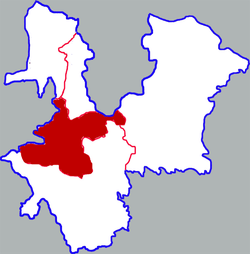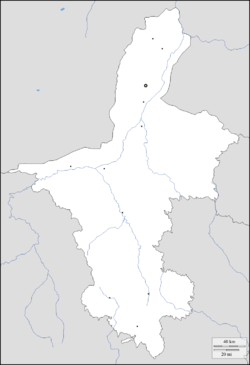Hongsibu District
Hongsibu District (simplified Chinese: 红寺堡区; traditional Chinese: 紅寺堡區; pinyin: Hóngsìbǔ Qū (official), Hóngsìpǔ Qū (local)[1]) is a district within the prefecture-level city of Wuzhong in the autonomous region of Ningxia, China.
Hongsibu 红寺堡区 Hongsipu | |
|---|---|
 Hongsibu District in Wuzhong, Ningxia | |
 Hongsibu Location in Ningxia | |
| Coordinates: 37.317°N 106.101°E | |
| Country | People's Republic of China |
| Region | Ningxia |
| Prefecture-level city | Wuzhong |
| Established | 2009 |
| Seat | Town of Hongsibu (红寺堡镇) |
| Government | |
| • Secretary | Ding Jiancheng |
| • Governor | Tan Xingling |
| Area | |
| • Total | 3,523 km2 (1,360 sq mi) |
| Population (2010 Census) | |
| • Total | 165,016 |
| • Estimate (2015) | 197,350 |
| • Density | 47/km2 (120/sq mi) |
| Time zone | UTC+8 (China Standard) |
| Postal code | 751900 |
| Area code(s) | 0953 |
| Website | www |
Geography
Hongsibu is located 127 kilometres (79 mi) south of the regional capital Yinchuan.[2] It covers an area of 3,523 square kilometres (1,360 sq mi)[3] in a basin bounded by Mount Niushou (牛首山, 1,774 m (5,820 ft)) in the north, Mount Yantong (烟筒山, 1,715 m (5,627 ft)) in the west and Mount Luo (罗山, 2,624 m (8,609 ft)) in the east;[4] the last has been designated a National Nature Reserve.[5] The terrain is higher in the south than the north and the elevation generally ranges between 1240 and 1450 m above sea level.[2]
History
Hongsibu first appears as a place name during the Ming dynasty.[2]
Beginning in 1998, the area now comprising the district was chosen as a resettlement location for people from drought-stricken areas of southern Ningxia.[6] In the most ambitious scheme of its kind in China,[7] water was diverted from the Yellow River to create and irrigate 60 square kilometres (23 sq mi) of new agricultural land.[2] The administrative district was established in 2009.[3]
Administration
Hongsibu District is divided into the towns of Hongsibu (红寺堡镇) and Taiyangshan (太阳山镇) and the townships of Xinzhuangji (新庄集乡), Dahe (大河乡) and Liuquan (柳泉乡),[2] the last of which was created in 2014 from the western part of Xinzhuangji.[8] The District Party Committee Secretary is Ding Jiancheng (丁建成) and the District Governor is Tan Xingling (谭兴玲).[9]
Demographics
At the end of 2015 the population of Hongsibu District was estimated at 197,350, of which 29.23% lived in urban areas.[10] The district recorded a population of 165,016 in the 2010 national census[11] and 51,875 in the 2000 census.[8]
Economy
Hongsibu District's gross domestic product was estimated at CN¥1.56 billion in 2015.[10]
Infrastructure
The Dingwu, Fuyin and Gunhong expressways run through the northern part of the district, as does the Taiyuan–Zhongwei–Yinchuan Railway.[2] The Hongsibu Solar Park is located in the district.
References
- 红寺堡区简介 [Introduction to Hongsibu District] (in Chinese). Hongsibu news. Retrieved 2018-01-29.
- 红寺堡区基本概况 [Overview of Hongsibu District] (in Chinese). People's Government of Hongsibu District. Retrieved 2016-11-03.
- 宁夏回族自治区二〇〇九年县级以上行政区划变更情况. Ministry of Civil Affairs. 2009-09-30. Retrieved 2016-11-03.
- 红寺堡区 [Hongsibu District] (in Chinese). Ningxia News. 2011-08-17. Retrieved 2016-11-05.
- 宁夏罗山国家级自然保护区 [Ningxia Luoshan National Nature Reserve] (in Chinese). Retrieved 2016-11-05.
- Shu, Xihong (2016). The History and Present Condition of Ecological Migration in Ningxia. Ecological Migration, Development and Transformation: A Study of Migration and Poverty Reduction in Ningxia. Springer. p. 26.
- "The coal boom choking China". The Guardian. 2015-06-05. Retrieved 2016-11-04.
- "红寺堡区历史沿革" [History of Hongsibu District] (in Chinese). 2016-07-22. Retrieved 2016-11-04.
- "区委领导班子成员". People's Government of Hongsibu District. Retrieved 2016-11-05.
- "红寺堡区2015年国民经济和社会发展统计公报" [Hongsibu District 2015 Economic and Social Development Statistics Bulletin] (in Chinese). Hongsibu Statistics Bureau. 2016-04-25. Retrieved 2016-11-04.
- "宁夏回族自治区2010年第六次全国人口普查主要数据公报". National Bureau of Statistics of China. 2012-02-28. Retrieved 2016-11-04.